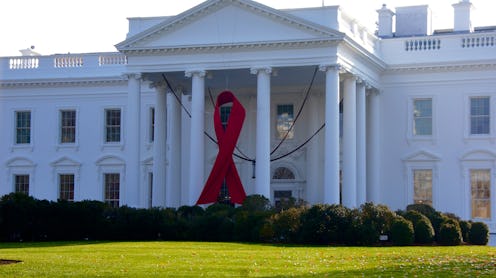
Tuesday, December 1 marks the celebration of World AIDS Day, a time for everyone across the globe to recognize the international struggle against HIV/AIDS, support those who have been diagnosed and remember those who have died. Ever since first being celebrated in 1988, World AIDS Day has given the world a chance to reevaluate the scale of the HIV virus and how we're treating this international concern which is still at epidemic proportions.
World AIDS Day is not just about raising awareness of global HIV/AIDS statistics (though that is a very important part) but teaching the public the truth about this virus, how it's spread, its symptoms and how to treat it. Along with fighting back against the disease, World AIDS Day is a solid reminder that we still need to fight stigmas attached to an HIV/AIDS diagnosis despite over 30 years of growth.
So how can you celebrate World AIDS Day? What ways can you contribute to the efforts to raise awareness while also commemorating those who have passed? Well, you can start by showing your support on social media by using the hashtag “#WAD2015” in your posts. But the best way is to get educated yourself. Here is everything you need to know about the mission of World AIDS Day and what will be taking place this year.
1. HIV/AIDS Is Still A Problem
Yes, it's 2015 and the number of HIV/AIDS cases have gone down dramatically since it first came on the scene in the '80s, but we're still not done with HIV/AIDS. We've made it possible to live long, full lives with treatments like antiretroviral therapies but HIV/AIDS is still spreading, and these sorts of treatments are not available to everyone.
According to the World AIDS Day Organization, over 34 million people living today have been diagnosed with HIV/AIDS, with 35 million having died since the disease was discovered in 1984. In the UK, about 6,000 people each year are still being diagnosed with HIV. The Center for Disease Control and Prevention also says that though HIV infection rates have fallen 35 percent since 2000, 66 percent of the 2 million new HIV infections happening globally each year are occurring in sub-Saharan African countries. And these diagnoses are mostly affecting women, who represent half the population in these areas.
As a result, this year's theme for World AIDS Day is The Time to Act Is Now , urging people across the planet to be more vigilant in their efforts to teach the public about how to prevent HIV/AIDS and how it spreads. So far in the United States, we've been doing a good job; through President Obama and the CDC's efforts with the U.S. President's Emergency Plan for AIDS Relief (PEPFAR), they have been able to give 13.5 million people in low and middle-income countries antiretroviral therapy (ART) in 2014.
But there is still a tremendous amount to be done.
2. We Need To Rethink HIV/AIDS
One of the best places to start is to rethink how we view HIV/AIDS in an attempt to remove any stigma or misconception that could keep the disease spreading. The World AIDS Day Organization is making it part of their campaign to erase misconceptions by spreading the facts on HIV/AIDS. One of their suggestions to raise awareness is to hold a bake sale with myth-busting facts expressed attached to baked goods. But if you're not particularly crafty in the world of baking, they also suggest holding a quiz night involving HIV/AIDS facts with members of your community to test their knowledge. And of course there's always social media.
A tweet detailing a little-known HIV/AIDS fact with the #WAD2015 could reach a lot more people than you may think. So hold off on posting those pics of what you ate that morning, and spread some info on Twitter.
Many people do not realize that HIV/AIDS doesn't have to be spread from an HIV positive mother to her child, or that an HIV diagnosis is not a virtual death sentence any more. It's also important to remind your community that we are all susceptible to contracting HIV/AIDS – it does not affect one community over another – and that the ways to prevent it involve safe sex practices like a condom (the Pill is not an effective prevention method against HIV).
This is just the tip of the iceberg when it comes to HIV/AIDS facts. To find out more about how the disease is contracted, current statistics, and what to do if you have been diagnosed, visit AIDS.gov for more info to share with your community.
3. This Is What The White House Is Doing
Because the World AIDS Day Organization's events are mostly taking place in the UK, it's important to know what's going on in our own backyard. The White House will be holding a live webcast from 1:00 p.m. to 3:15 p.m. EST showing all of its events going on for World AIDS Day. Because President Obama is dedicated to an AIDS-free generation, the webcast will also feature his discussion on Sustainable Development Goals along with the most recent release of the National HIV/AIDS Strategy: Updated to 2020. You can watch the webcast on www.whitehouse.gov/live to learn more about the actions our country is taking to eliminate the disease.
4. You Can Show Your Support
The simplest way to show your support for Worlds AIDS Day is to wear the red ribbon, symbolizing solidarity with the HIV/AIDS awareness cause. If you're looking to go beyond that, UNAIDS.org has images and graphs that you can download and post to social media in order to tell your followers about the holiday, and spread HIV/AIDS facts.
Don't be afraid to inquire about how your community is celebrating World AIDS Day and what you can do to help those efforts! Remember, any way you can spread knowledge about the virus is the best way to show your support.
Images: Flickr/ Ted Eytan